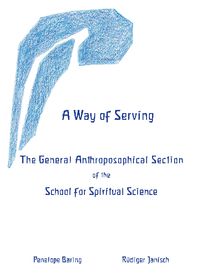
An Introduction to the School for Spiritual Science
At the heart of the Anthroposophical Society is the School for Spiritual Science, an institution intended to be an esoteric school for spiritual scientific research and study.
During the course of 1924 Rudolf Steiner held 19 esoteric lessons in which he introduced his followers to a series of meditations (mantras) along with instructions and guidelines for their use. This set of lessons is known as the First Class and they are made available to those who become members of the School.
After Steiner’s death in 1925 the members of the Executive Council (Vorstand) at the Goetheanum began to convey the contents of these lessons to members of the First Class. Other leaders in the Anthroposophical Society were also assigned to take on this task and circles of Class holders grew in various countries around the world.
Today members of the Anthroposophical Society have the opportunity to become members of the First Class and to participate in the instructional lessons.
Sections of the School
The School for Spiritual Science is organized into departments, called “sections,”
for the purpose of conducting spiritual-scientific research within various professional fields.
Each Section administers its own study and work. Representatives from the Sections meet together as a Collegium. In North America there is one Collegium serving Canada, the U.S. and Mexico. All members of the First Class belong to the General Anthroposophical Section, the Section common to all.
Individuals who are interested in the work of the First Class of the School for Spiritual Science should contact a local group or branch of the Anthroposophical Society. Detailed information about membership can be found in the booklet A Way of Serving: The General Anthroposophical Section of the School for Spiritual Science by Penelope Baring and Ruediger Janisch (Mercury Press, 2013). This book may be ordered through www.mercurypress.org
General Anthroposophical Section
The General Anthroposophical Section is both the starting point and the center of the School for Spiritual Science. Here a foundation is laid step by step for all branches of spiritual research. The three core subjects are: anthroposophical study of the human being; evolution and the history of humanity; and the science of initiation. These fields cover the broad outlines of anthroposophy.
In 1924, Steiner developed the course of study based on meditative exercises that lead “the spiritual in the human being to the spiritual in the universe.” This is the basis for the work of the School for Spiritual Science. It is also the background of the research, teaching, and training activities of the General Anthroposophical Section.
Section for Mathematics and Astronomy
The work of the Section for Mathematics and Astronomy includes qualitative investigations into measure, number, and weight; studies on the morphology of the starry sky and its constellations; and cosmological study of the human being and rhythm research. Particular importance is attached to projective geometry as the foundation of a new morphology and physics. Research on correspondences between the macrocosm and microcosm and on the place of the human being in this context draws the section into close collaboration with the pedagogical, medical, and agriculture fields.
- See the joint website with the Natural Science Section.
Medical Section
The Medical Section devotes itself to medical and pharmaceutical research, as well as to training and continuing education of physicians, pharmacists, and therapists. Faced with the pathogenic aspects of modern life, it supports “culturally therapeutic” causes, methodological plurality in scientific discourse, patient’s right to choose, and the legal battle for complementary medicine. In its collaborative work with the artistic and scientific sections, two core questions of anthroposophical medicine are central: How does health arise? What is the nature of disease and healing?
- Contact: Gerald Karnow, MD [email]
Natural Science Section
By the beginning of the 20th century, science – biology, physics, chemistry – began hitting its own limits. The task of the Natural Science Section is to push beyond these limits, to explore further, to set out from new premises leading to new results and capacities. The foundation for its work is the scientific method developed by Goethe and further developed by Steiner. The key question underlying all considerations is: Can we, by honoring the appearances of the phenomena, reach a scientific understanding that is true to the living world, its supersensible dimensions, and its specific life connections?
- Visit the section website.
- Find out about the new section newsletter.
Agricultural Section
In the Agricultural Section, the focus is on research, collaboration, and public representation in the areas of soil management, crop cultivation, animal husbandry, and the farm organism. Knowing and working with planetary-earthly correspondences is basic to the biodynamic method of agriculture as practiced worldwide. These experiences lead to social and economic perspectives, to insights and practical implications for market structuring and to associative activity on regional, national, and international levels. [More about the Section and biodynamic agriculture.]
- Contact: Sherry Wildfeuer (email) 610 935-0302
Pedagogical Section
For the Pedagogical Section, education is the foundation of social progress. The seeds of self-determination, tolerance and peace, human rights, and international understanding are sown in education. This is the art of Waldorf pedagogy. The chief task of the Pedagogical Section is educational research and development based on the anthroposophical image of the human being. The Section supports ideas and initiatives to address the generational problems and the changing needs it perceives in children.
- Contacts: Elan Leibner (email) 609-466-1306, and Judith Lucas (email) 303-523-0077
- Website: Pedagogical Section Council
Section for the Spiritual Striving of Youth
The Section for the Spiritual Striving of Youth sees its purpose more in connecting and advising than in research and teaching. It is a vibrant hub, a place of meeting, exchange, and stimulation. At the same time, it is a place to explore new initiatives and find ways to realize them. The essential aim of the Section is future oriented: to support young people in their spiritual striving, their need to understand the world, and their urge to be active.
- Contact: Frank Agrama [email].
Section for Social Sciences
The Section for Social Sciences is concerned with human relationships in the three spheres of social life: economic, legal, and cultural/spiritual. Depending on the sphere, different fundamental questions arise: How are the basic needs of the world's population to be met? What responsibility does a good citizen bear for the common good? What does a human being need from the world in order to reach his or her potential? With such questions in mind, the Section conducts research, pursuing insight and creative forms in a variety of areas including: family culture, biography work, conflict resolution/peace studies, addiction, economics questions, and the science, practice, and politics of law.
- Contact: Christine Burke (email)
Section for the Arts of Eurythmy, Speech, Music, Puppetry, and Drama
Also referred to as the Performing Arts Section, its various areas of activity cultivate the beneficial and sustaining presence of what lives in sound and word, and furthers our humanness.
It is characteristic of these arts that they share the common landscape of temporal qualities. Often referred to as the time arts (in contrast to the visual arts), they all unfold and are experienced in the differentiated flow of time. Artists who have completed rigorous professional training in these arts are typically involved in pedagogical work, adult professional education, therapeutic work, enrichment in the workplace, and performance.
- Contact: Helen Lubin (email) 916-966-5749
Visual Arts Section
The Visual Arts Section embraces painting, sculpture and architecture, furniture design, glass engraving, color studies and plant-color research, as well as newer artistic mediums like installation, light art, and performance art. Art therapy and art education are also included through inter-sectional work. The process of cultivating Steiner's artistic ideas and developing them further leads to creative working relationships, international exhibitions and events, lectures, colloquia and courses on artistic topics. — There is an international English-language Art Section Newsletter that anyone can subscribe to, either print or pdf versions; for more information see the Section website:
The Literary Arts and Humanities Section
The Literary Arts and Humanities Section seeks on the basis of anthroposophical spiritual science to research and enliven those realms known generally as the humanities—among them creative writing, literature, linguistics, translation, aesthetics, history, and philosophy. A significant aspect of the Section’s work is researching and cultivating language as the living link between content and form, and as a bridge between the physical world and the world of the spirit. Members of the First Class of the School for Spiritual Science who determine for themselves that they have a professional calling in the tasks and spiritual scientific research of the Literary Arts and Humanities are welcome to become members of the Section. Like membership in the School itself, membership in the Section is a conscious decision to participate actively, to enter into fruitful and fulfilling relationships with Section colleagues. Inquiries about the Section, membership, and the Section’s activity are always most welcome. A biannual Newsletter has shared news of the Section in North America and worldwide; provided a venue for Section members to publish research results; and endeavored to nurture collegial relationships.
- Contact: is Bruce Donehower [email]. For some examples of the ongoing work of this Section in Northern California, go to theliteraryarts.com
The North American Collegium
The Collegium is a forum to gain an overview of the School as a whole. It consists of representatives from each of the Sections of the School for Spiritual Science, the General Secretaries of the United States and Canada, and Joan Sleigh from the Goetheanum. The task of the Collegium from its inception has been to evolve a fuller, cohesive picture of the School, which had been previously identified primarily with the Lessons of the First Class. The theme of spiritual research has been explored collaboratively over many years, as well as the articulation of the activities that belong to the General Anthroposophical Section (see, for example, the booklet A Way of Serving).
The School’s Work at the Goetheanum
This page focuses on work in North America; the center of the school’s worldwide activity, with much in English, is at the Goetheanum.
General Anthroposophical Section — Section for Mathematics and Astronomy — Medical Section
Natural Science Section — Section for Agriculture — Pedagogical Section
Visual Art Section — Section for the Performing Arts — Section for the Literary Arts and Humanities
Section for Social Sciences — Youth Section

